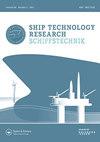Propeller optimization by interactive genetic algorithms and machine learning
IF 0.9
Q3 ENGINEERING, MARINE
引用次数: 4
Abstract
ABSTRACT Marine propeller design can be carried out with the aid of automated optimization, but experience shows that a such an approach has still been inferior to manual design in industrial scenarios. In this study, the automated propeller design optimization is evolved by integrating human–computer interaction as an intermediate step. An interactive optimization methodology, based on interactive genetic algorithms (IGAs), has been developed, where the blade designers systematically guide a genetic algorithm towards the objectives. The designers visualize and assess the shape of the blade cavitation and this evaluation is integrated in the optimization method. The IGA is further integrated with a support-vector machine model, in order to avoid user fatigue, IGA's main disadvantage. The results of the present study show that the IGA optimization searches solutions in a more targeted manner and eventually finds more non-dominated feasible designs that also show a good cavitation behaviour in agreement with designer preference.交互式遗传算法和机器学习的螺旋桨优化
摘要船舶螺旋桨设计可以借助自动化优化进行,但经验表明,在工业场景中,这种方法仍然不如手动设计。在这项研究中,自动螺旋桨设计优化是通过整合人机交互作为中间步骤而发展起来的。已经开发了一种基于交互式遗传算法(IGAs)的交互式优化方法,其中叶片设计者系统地引导遗传算法实现目标。设计者对叶片空化的形状进行可视化和评估,并将此评估集成到优化方法中。IGA进一步与支持向量机模型集成,以避免用户疲劳,这是IGA的主要缺点。本研究的结果表明,IGA优化以更有针对性的方式搜索解决方案,并最终找到更多的非主导可行设计,这些设计也显示出符合设计师偏好的良好空化行为。
本文章由计算机程序翻译,如有差异,请以英文原文为准。
求助全文
约1分钟内获得全文
求助全文

 求助内容:
求助内容: 应助结果提醒方式:
应助结果提醒方式:


